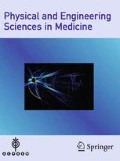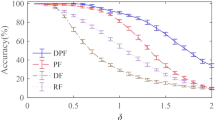Abstract
Manipulation of biological particles including pulling, and holding-and-indenting them, using the atomic force microscope (AFM) has attracted enormous interests. High deformability and vulnerability of biological particles, especially cells, make moving toward the target point inside complex biological environments with the least invasion the most critical factor. In this article, the optimal path of the particle movement is determined by considering the mechanical and morphological properties of the biological cell. Furthermore, the shortest path with the least amount of cell deformation is determined by using the equations of 3D manipulation of spherical viscoelastic particles and genetic algorithm (GA). Eventually, the final path is determined considering the mechanical properties of breast cancer cells by applying different constraints such as folding factor and the particle’s roughness.
Results reveal that increasing the number of constraints raise the needed time to find the optimal path. Additionally, the maximum time belongs to the spherical particle in the presence of folding. As a result, the total path planning times for the smooth, rough, and folded spherical particle are 59.386, 129.578, and 214.404 s, respectively. Various optimal pathfinders are used, to reduce calculations and speed up the process, as well as obtaining the correct answer with high certainty. Comparing the error files founded for three methods including cellular learning Automata, Dijkstra, and GA, the third method has the best performance in the lowest error rate. Using the GA, the error rate can be reduced by 40%, compared to the cellular learning Automata method. Furthermore, comparing the cellular learning Automata method used in previous studies, it can be seen that not only the results are correct, but also less time spent, at the practically identical situation, on finding the optimal path for this algorithm.












Similar content being viewed by others
References
Kuhn HW (1955) The Hungarian method for the assignment problem. Nav Res Logist Q 2(1–2):83–97
Mokaberi B, Yun J, Wang M, Requicha AAG. (2007). Automated nanomanipulation with atomic force microscopes. IEEE International Conference on Robotics and Automation, pp. 1406–1412
Duchoň F et al (2014) Path planning with modified a star algorithm for a mobile robot. Procedia Eng 96:59–69
Gao Z, LécuyerA. (2009). Path-planning and manipulation of nanotubes using visual and haptic guidance, in Virtual Environments, Human-Computer Interfaces and Measurements Systems. VECIMS’09. IEEE International Conference on Virtual Environments, Human-Computer Interfaces and Measurements Systems , pp. 1–5
Requicha AAG, Arbuckle DJ, Mokaberi B, Yun J (2009) Algorithms and software for nanomanipulation with atomic force microscopes. Int J Robot Res 28(4):512–522
Feddema JT, Xavier P, Brown R (2001) Micro-assembly planning with van der Waals force. Int J Micromechatron 1(2):139–153
Eberhart RC, Shi Y, Kennedy Y. (2001). Swarm Intelligence (Morgan Kaufmann series in evolutionary computation). Morgan Kaufmann Publishers
Hu S, Sun D (2011) Automatic transportation of biological cells with a robot-tweezer manipulation system. Int J Robot Res 30(14):1681–1694
Korayem MH, Nosoudi S, Far SK, Hoshiar AK (2018) Hybrid IPSO-automata algorithm for path planning of micro-nanoparticles through random environmental obstacles, based on AFM. Int J Mech Sci Techno 32(2):805–810
LaValle SM, Kuffner JJ Jr (2001) Randomized kinodynamic planning. Int J Rob Res 20(5):378–400
Ju T, Liu S, Yang J, Sun D (2014) Rapidly exploring random tree algorithm-based path planning for robot-aided optical manipulation of biological cells. IEEE Trans Autom Sci Eng 11(3):649–657
Steager EB, Selman Sakar M, Magee C, Kennedy M, Cowley A, Kumar V (2013) Automated biomanipulation of single cells using magnetic microrobots”. Int J Robot Res 32(3):346–359
Chowdhury S, Thakur A, Svec P, Wang C, Losert W, Gupta SK (2014) Automated manipulation of biological cells using gripper formations controlled by optical tweezers. IEEE Trans Autom Sci Eng 11(2):338–347
Johnson KL, Kendall K, Roberts AD (1971) Surface energy and the contact of elastic solids. Proc R Soc Lond A 324(1558):301–313
Korayem MH, Hoshiar AK, Nazarahari M (2016) A hybrid co-evolutionary genetic algorithm for multiple nanoparticle assembly task path planning. Int J Adv Manuf Technol 87(9–12):3527–3543
Korayem MH, Mahmoodi Z, Taheri M, Saraee MB (2015) Three-dimensional modeling and simulation of the AFM-based manipulation of spherical biological micro/nanoparticles with the consideration of contact mechanics theories. Proc Instit Mech Eng, Part K: J Multi-Body Dyn 229(4):370–382
Gascoyne PRC, Shim S (2014) Isolation of circulating tumor cells by dielectrophoresis. Cancers 6(1):545–579
Li QS, Lee GYH, Ong CN, Lim CT (2008) AFM indentation study of breast cancer cells. Biochem Biophys Res Commun 374(4):609–613
Gorb SN (2011) Review of" contact mechanics and friction: physical principles and applications" by Valentin L. Popov. Beilstein J Nanotechnol 2:57
Wong CC, Reboud J, Soon J, Neuzil P, Liao K (2011) Detachment dynamics of cancer cells. Exp Appl Mech 6:881–882
Cooper K, Ohler N, Gupta A, Beaudoin S (2000) Analysis of contact interactions between a rough deformable colloid and a smooth substrate. J Colloid Interface Sci 222(1):63–74
Korayem MH, Motaghi A, Zakeri M (2011) Dynamic modeling of submerged nanoparticle pushing based on atomic force microscopy in liquid medium. J Nanoparticle Res 13(10):5009
Korayem MH, Shahali S, Rastegar Z (2018) Experimental determination of folding factor of benign breast cancer cell (MCF10A) and its effect on contact models and 3D manipulation of biological particles. Int J Biomech Model Mechanobiol 17(3):745–761
Author information
Authors and Affiliations
Corresponding author
Ethics declarations
Conflict of interest
The authors declare that they have no conflict of interest.
Ethical approval
For this type of study, formal consent is not required.
Informed consent
This article does not contain any studies with human participants or animals performed by any of the authors.
Additional information
Publisher's Note
Springer Nature remains neutral with regard to jurisdictional claims in published maps and institutional affiliations.
Rights and permissions
About this article
Cite this article
Korayem, M.H., Shahali, S., Rastegar, Z. et al. Path planning of the viscoelastic micro biological particle to minimize path length and particle’s deformation using genetic algorithm. Phys Eng Sci Med 43, 903–914 (2020). https://doi.org/10.1007/s13246-020-00887-y
Received:
Accepted:
Published:
Issue Date:
DOI: https://doi.org/10.1007/s13246-020-00887-y



